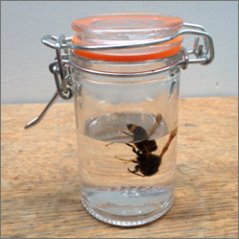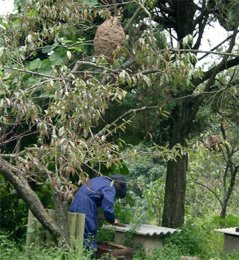Generic article
Vespa velutina
Tjeerd Blacquiêre
This wasp was a bit too greedy (thirsty?) when she chose my glass of white wine on a terrace in Minerve in Southern France during my autumn holiday. So I saved her, taking her with me in a spectacle case, and after cooling down in the freezer I put her in real strong liquor: 96% alcohol, this time with peppermint smell.
Vespa velutina on Ivy

During our walks between the vineyards we saw that alike in the Netherlands flowering Ivy (Hedera helix) is a popular foraging site. But we did not see hover flies nor honey bees on the flowers, but (almost) only hornets, both the European hornet (Vespa crabro) and the Asian hornet (Vespa velutina). Particularly from the latter species many specimens. The Asian hornet is a little smaller in size than the European hornet.
On Malta I saw Vespa orientalis, the Eastern hornet which looks much alike the Asian hornet and which is also about equal in size. V. orientalis is widespread in the southern part of Italy and Greece and appears not to be a great threat for honey bees.
A ‘wild’ apiary in St. Germain (back in the Languedoc, France) in old beehives under a roof, which I now follow for a few years was still populated. We did not see any Asian hornets around only several small wasps that used part of the hives as shelters. Whether the Asian hornet could be also a threat to honey bees in ‘the wild’ I am unaware of, but fact is that beekeepers in the Provence and in Liguria consider the wasp to be a serious threat especially in summer when the nests become very big (see photograph from China). How far the wasp could migrate and settle to the North still has to be learned. At least the species is going much further north than Vespa orientalis.
Will our bees adapt?

Peter Neumann told me a nice story about Apis cerana bees in Yunnan (China), which were able to avoid and escape the hunting wasps (not only V velutina), and how they collectively moved in and out the hive to not be caught. They even together performed ‘the wave’ on the entrance of the hive in order to prevent the wasp to be able to select an individual to catch. The most remarkable story was that of a beekeeper who went out in spring into the woods to collect young Vespa nests, which he cut of and later took to his apiary, and carefully mounted onto his apiary roof or branches of trees. During summer you could see big nests of Vespa velutina above his head (See photograph) and wasps together with bees flying in and out of the apiary. According to the beekeeper it made his colonies stronger and fleshier. IF so, how could we explain this? Maybe because the wasps selectively catch sick or weak bees, and thereby improving the health status of the colonies? Or maybe the wasps protect the bees because some other predators do not dare to approach the api-vespiary?
Maybe also an approach to try when the wasp enters the Benelux?